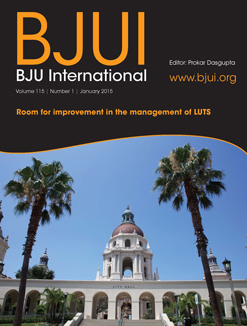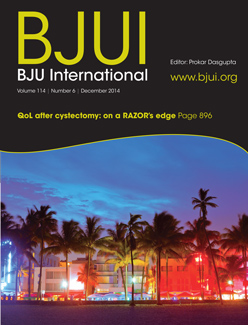
Editorial: The Prostate – The gateway to men’s health
We have been told for many years that the management of men with LUTS due to BPH was, for most, about treating the impact of those symptoms on their quality of life. However, evidence has been accumulating over recent years to suggest that BPH may be associated with the various components of the metabolic syndrome – a combination of central obesity, impairment of glucose tolerance, dyslipidaemia and hypertension. Hammarsten et al. [1] examined the link between BPH and 22 individual aspects…

Editorial: Cognitive training and assessment in robotic surgery – is it effective?
A formal and standardised process of credentialing and certification is required that should not merely be based on the number of completed cases but should be done via demonstration of proficiency and safety in robotic procedural skills. Therefore, validated assessment tools for technical and non-technical skills are required. In addition to effective technical skills, non-technical skills are vital for safe operative practice. These skill-sets can be divided into three categories; social (communication,…

Of Cricket and Urology: USICON 2015
2 Comments
/
The Indian captain MS Dhoni has retired from Test cricket after the MCG test in Australia. The timing of this announcement from a national hero has left opinions divided amongst pundits and people in a cricket mad nation. See the video on NDTV here.
One of India's most successful captains, wicket-keeper and unorthodox batsmen, MS will now focus on one day and T20 cricket. With 3.3M followers on Twitter (@msdhoni) his popularity remains unabated, with Sky sports dedicating a program to highlight…

Editorial: RPLND – Open Surgery’s Next Challenger Is Ready To Enter The Ring
By Tim Dudderidge
The da Vinci surgical system delivers the benefits of laparoscopic surgery with an easier and more precise human–tissue interface than conventional laparoscopic instruments. Nearly all major uro-oncological procedures are being performed robotically. In this issue of BJUI, Cheney et al. [1] present their technique and initial experience of robot-assisted retroperitoneal lymph node dissection (RA-RPLND) for patients with primary and post-chemotherapy non-seminoma germ cell…

Editorial: Bone Metastases in Prostate Cancer: Which Scan?
In this issue of BJUI, Poulsen et al. [1] present a prospective comparison of 18F-fluoride (NaF) and 18F-choline (FCH) positron emission tomography (PET)/CT with planar whole-body bone scintigraphy (WBS) using spinal MRI, including short tau inversion recovery (STIR), T1 and T2 sequences, as the reference standard in 50 hormone-naïve patients with confirmed bone metastases on WBS. They found that both PET/CT methods were significantly more sensitive and accurate than WBS and that FCH PET/CT…

Is active surveillance the way to go for stage I nonseminoma testicular cancer?
The December 2014 international urology journal club on twitter featured the large Danish population study published on Journal of Clinical Oncology. Daugaard et al reported this population based retrospective cohort study of 1226 patients who had been diagnosed with stage I nonseminoma testicular cancer and then managed by active surveillance from 1984 to 2007. Followed up was up to 2012 with a median follow up of 180 months (range, 1 to 346 months).
As usual, contributions to the discussion…

24 hour live Worldwide Robotic Surgery Event February 16th – 17th 2015
On the 16-17th February 2015 ten leading robotic centers of excellence from 4 continents will broadcast for 24 continuous hours. All the surgeons operating are experienced live surgeons, pioneers in their fields, who have contributed to the development and advancement of excellence in robotic surgery techniques.
Register now at www.wrse24.org
WRSE24 incorporating 10 world leading robotic centres.
“Imagination is more important than knowledge. For knowledge is…

Editorial: Complex tumours, partial nephrectomy and functional outcomes
In the paper by Volpe et al. [1], excellent renal functional outcomes are associated with partial nephrectomy in patients with high PADUA score cancers. The study is notable because it shows that, even in patients who are typically considered candidates for radical nephrectomy, partial nephrectomy can maintain excellent estimated GFR (eGFR) and outcomes; however, because we perform nephron-sparing procedures on patients who may also be candidates for radical nephrectomy, we must consider the varied…

Editorial: Histone deacetylase inhibition: a new target for Peyronie’s disease?
Peyronie's disease is a chronic and progressive disease characterised by fibrotic plaque of the tunica albuginea of the penis that can cause deformity, pain during erection and erectile dysfunction. Fibrosis is the hallmark of the pathology of Peyronie's disease and is known to be driven by fibroblasts and myofibroblasts, which produce excessive amounts of extracellular matrix proteins and, hence, disturb the architecture of the tunica albuginea.
In this issue of BJUI, Kwon et al. [1] have…

Surgical Science – everything is not what it seems
It has been another successful year for the BJUI. Our impact factor has gone up, the new design theme of ‘places’, featuring the location of the ‘Article of the Month’ on the front cover, has been well received and our web statistics have gone from strength to strength. Despite these successes, as a surgeon-scientist, I occasionally find that I am questioning myself, particularly where surgical science is concerned.
One such moment came recently while I was performing a live nerve-sparing…
